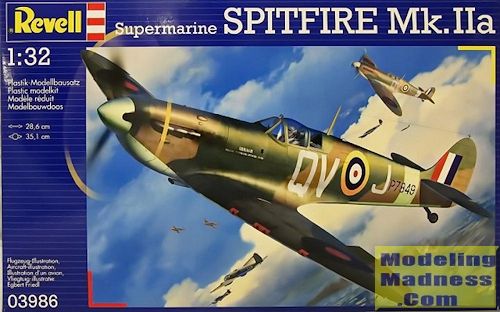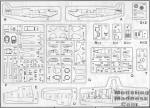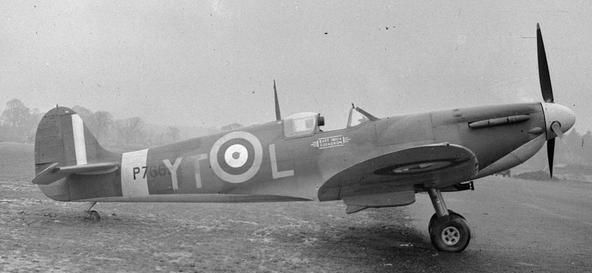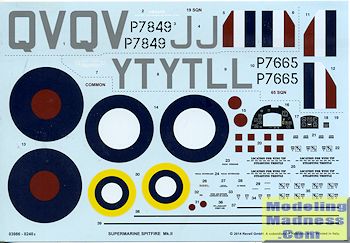
| KIT #: | 03986 |
| PRICE: | $29.95 SRP |
| DECALS: | Two options |
| REVIEWER: | Scott Van Aken |
| NOTES: | New tool kit |

| HISTORY |
There is probably not a British citizen who does not know about the Spitfire, even if it is vaguely. With the 75th anniversary of the Battle of Britain fresh in everyone's consciousness, there have been undoubtedly all sorts of newscasts and specials on the telly to commemorate the event. Naturally, then as now, the main plane is the Spitfire.
It is, I guess, somewhat typical that the beauty of the bunch gets all the recognition while that which really won the battle, the Hurricane, is relegated to behind the stage. It was the Hurricane that shot down the most German bombers, the Hurricane that was flown by the majority of pilots and squadrons and the Hurricane that first saw action with the RAF in France.
The Spitfire, while undoubtedly a beautiful aircraft had several shortcomings. One is that it was a short range interceptor. This meant that, even with drop tanks, later in the war it could not escort bombers over enemy territory that was much beyond the coast of France. It was a poor fighter-bomber thanks to its liquid cooled engine and minimal carrying capability and an even poorer carrier borne fighter, thanks to its narrow and weak undercarriage which was not suited for hard landings. It was also expensive to build and slow to be repaired, unlike the Hurricane. Yet it remained in service and production from before the war until several years after.
| THE KIT |
 Recently,
Revell AG brought out this kit. It was much anticipated by the Spit boffins, but
anticipation turned into rancor when the kit reached modeler's hands. Revell had
really screwed the pooch on this one and it is a real mystery as to why, what
with a number of early Spitfires available for researchers either in museums or
as warbirds.
Recently,
Revell AG brought out this kit. It was much anticipated by the Spit boffins, but
anticipation turned into rancor when the kit reached modeler's hands. Revell had
really screwed the pooch on this one and it is a real mystery as to why, what
with a number of early Spitfires available for researchers either in museums or
as warbirds.
First of all, it has metal ailerons, something not seen on Spitfires until later variants. It also has the larger oil cooler of the Mk.V, a prop spinner that is either too short or too long depending on the prop and the blades are too fat for proper deHavilland editions. There is no seat armor plating, the underside of the wing has an odd bulge not there on the real plane and the rear cockpit section is too small. Finally, the wheels are not dished but the centers bulge outward. Though not a glitch but an unnecessary item are separate flaps. This latter item was always up on the ground as it blocked cooling air from going through the radiator and caused the engine to overheat. There are several kits that include deployed flaps where they were always 'up' on the ground so while this is not a biggie, it adds to the complexity of the build. I'm sure there are other glitches, but these are the big ones. Fortunately, aftermarket has already come to the rescue on most of these items, but it adds significantly to what starts out as a reasonably priced kit.
Now that is out of the way, here are a few of the other features. It does have a nicely done cockpit with a lot of detail. You can either paint the instrument panel or use the supplied decals. There is no belt detail for the seat, but you can easily find p.e. additions for this. I like that when you put the fuselage halves together, you positively trap the prop shaft so that the prop can be added later and be able to spin. As mentioned, all the control surfaces are separate items so you can pose them in a more dynamic position. Don't forget to show the control column in the proper angle if you do this.
The wing is a single lower piece with separate upper halves.
Wing tips are separate as well, showing that perhaps Revell is considering other
variants. I also like that the exhaust can be installed from the outside. The
exhaust door one the radiator can be posed open as well. The cockpit door is
separate and includes a crowbar, which was not installed on the early Spitfires
so you'll need to sand that away. An armored windscreen part is included. It
would be nice to have had this already molded on the windscreen as attaching and painting it
is more difficult as a separate piece. The radio mast seems to be missing the
triangular piece at the top that one sees on Spits and Hurricanes of this era.
However, look at period photos (warbirds are, often as not, wrong in many
details) as this was not always the case. I have included a period photo of one
of the two markings options which does not have the little 'flag' on the radio
mast. Note also how blunt the spinner is compared to the box art and that this
aircraft appears to have the Rotol prop.
to have had this already molded on the windscreen as attaching and painting it
is more difficult as a separate piece. The radio mast seems to be missing the
triangular piece at the top that one sees on Spits and Hurricanes of this era.
However, look at period photos (warbirds are, often as not, wrong in many
details) as this was not always the case. I have included a period photo of one
of the two markings options which does not have the little 'flag' on the radio
mast. Note also how blunt the spinner is compared to the box art and that this
aircraft appears to have the Rotol prop.
 Instructions
are normal for Revell. The pages are large, the illustrations well drawn, and
all paint references are with Revell paints meaning that some colors will need
to be mixed. Markings are for two brown and green over sky airplanes from before
the yellow ID bands. These have sky spinners and fuselage bands which will need
to be painted. Markings are provided for two planes. One is the box art plane
from 19 Squadron in June of 1941 and the other is from 65 squadron in July of
1941. The decals are very nicely done and provide stencils as well.
Instructions
are normal for Revell. The pages are large, the illustrations well drawn, and
all paint references are with Revell paints meaning that some colors will need
to be mixed. Markings are for two brown and green over sky airplanes from before
the yellow ID bands. These have sky spinners and fuselage bands which will need
to be painted. Markings are provided for two planes. One is the box art plane
from 19 Squadron in June of 1941 and the other is from 65 squadron in July of
1941. The decals are very nicely done and provide stencils as well.
| CONCLUSIONS |
So the end result is a flawed kit. Fatally flawed in the eyes of some and fixable to a certain extent in the eyes of others. Then there are those who are not at all concerned and will build it, glitches and all. I'm disappointed that such a well known and easily accessible aircraft could have been kitted so badly. I will buy whatever bits are needed from the aftermarket folks and give it a go as I like the airplane. You will have to decide if it is for you.
September 2015
Thanks to me
for the preview kit. If you would like your product reviewed fairly and
fairly quickly, please
contact
the editor or see other details in the
Note to
Contributors.